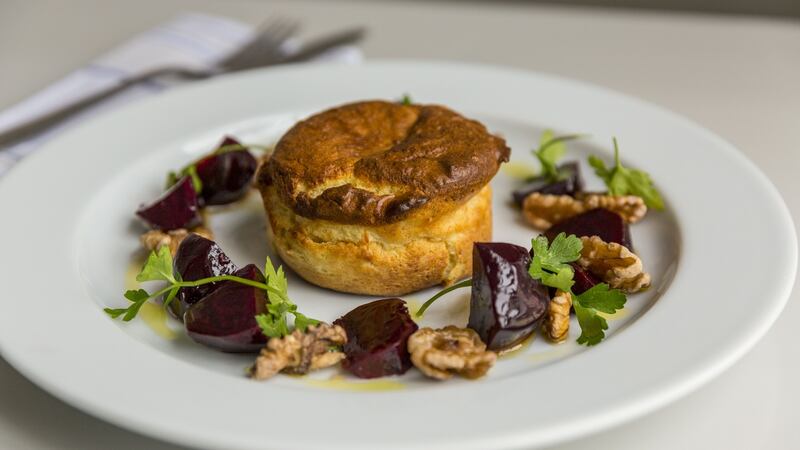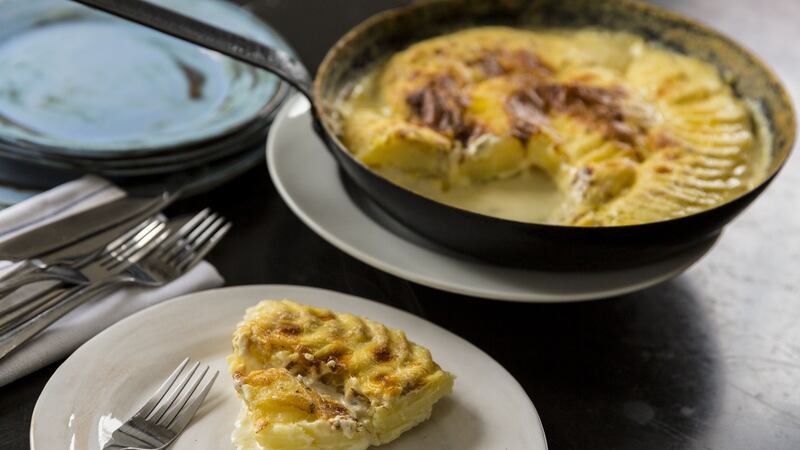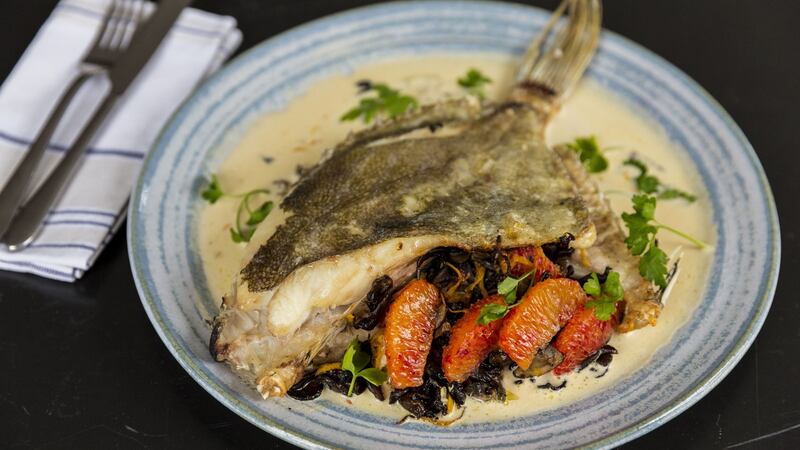Food has a way of transporting us back to the past, through the smells, tastes and textures playing with our memories. We use food to connect with each other and from those moments we build our memories.
Every time I’m in the kitchen there isn’t an ingredient, cooking process or dish that doesn’t trigger some memory – be it the familiar grower’s work, my daughters whims, the wisdom of a chef I have worked with, friends or students who have passed on a tip, or memories of a customer who orders the same dish time after time.
My two great mentors, Colin White and Stephen Markwick, are my constant source of memories while I am cooking, planning my menus and teaching. They both cooked with the famous George Perry-Smith of the Hole in the Wall in Bath, and from there learnt to cook with honesty, instinct and a sense of generosity. They instilled in me the importance of tasting and seasoning as soon as possible in a dish. I learnt from them how we must cook food we like to eat ourselves, we should never take shortcuts and we should always serve the dish to the best of our ability no matter who our guest is. So from the beginning of any cooking process fond memories of these great cooks and my time spent in their kitchens come flooding back as soon as I add the salt, and with every taste.
Over the years it has become very obvious that I am better at recalling my customers by their dishes than by their names. We have the fish soup people (now family friends), the meringue family, the ham man, the mezze girl, the lobster family, and the very stylish crab tart ladies (from the wonderfully stylish Wish in Skibbereen). I’ve always felt it’s an honour to be part of my customers’ food memories as I know how much mine mean to me, and I have made many friends through the shared appreciation we have built up of good food. Similarly, memories of past staff come flooding back when I’m cooking a dish that I would have created during their time with us.
Food creates memories and memories create great dishes. We must keep cooking dishes that we so love to share and enjoy.

Twice-baked cheese soufflés
I remember every detail of the first time I saw a soufflé being made and eating it for dinner. I was so blown away by how simple and delicious it was. It was a dinner at a friend's house in France and a typical midweek dish for when there are bits and pieces in the fridge.
This particular recipe is taken from my mentor Stephen Markwick's book An Honest Cook.
They’re ideal as they can be made in advance, kept in the fridge for a few days or individually frozen and used as needed. How cool to be able to say to an unexpected guest “Just let me go and whip up a soufflé.”
Serves 8
6 medium eggs
55g strong cheddar
55g Gruyère
110g goat's cheese from a log
425ml full-fat milk
A slice of onion
1 bayleaf
85g butter
85g plain flour
1 tbsp Dijon mustard
Salt and pepper
Cayenne pepper
Nutmeg
8 ramekins (about 175ml)
Heat the milk with the onion and bay leaf and bring to the boil. Turn off the heat and place a lid on top and let it infuse while you prepare the rest of the ingredients.
Separate the eggs, putting the whites into the bowl of a food mixer for beating later. Grate the hard cheeses and cube the goat’s cheese. Pre-heat the oven to 190C.
In a pan melt the butter and stir in the flour to make a roux (a thick flour-and-butter paste). Bring the infused milk back to the boil and gradually beat it in to the paste, whisking as you do, and letting it simmer after each addition until the mixture thickens.
Next add in the cheddar and Gruyère, mix well and remove from the heat. Season with the mustard, Cayenne pepper, salt, pepper and a pinch of nutmeg.
Beat in the egg yolks well and then add the goat’s cheese.
Beat the egg whites with a food mixer until stiff, then fold them lightly but firmly through the soufflé base using a large metal spoon (this helps to cut the mixture).
Fill the buttered ramekin dishes with the mixture to just below the rim.
Take a roasting tray and line it with a tea towel. Place the soufflés on top and pour hot water into the tray just under halfway up and cook in the pre-heated oven for 20 to 25 minutes or until well risen and set.
Allow the soufflés to cool a little before turning them out (they will sink a little but don’t worry).
You can now store them in the fridge or freezer once they have cooled down.
When you are ready to serve them, preheat the oven to 200C and bake for 15 minutes until well risen.
Serve with a seasonal salad.

Dauphinoise potatoes
This is the best potato dish ever. It is a rich winter dish but wouldn’t be refused at anytime of the year. Ellen, my daughter, always requested it for her birthday in November and then the rest of the meal is worked around it. I have such fond memories of eating it late on a Saturday night after a busy week of service with bowls of green salad, a glass of wine and fun conversation with Stephen and Colin.
Serves 6 - 8
About 1kg rooster potatoes, peeled
Butter for greasing the dish
3 garlic cloves, peeled and crushed
½ litre whole milk
Sea salt and freshly ground pepper
250ml double cream
½ tsp freshly grated nutmeg, to taste
Preheat the oven to 200C/Gas 6.
Take a 28cm oven dish or oven-proof frying pan and butter it well. Sprinkle with the garlic, salt and pepper.
Cut each potato into coin-thickness slices and lay the potato into the pan, keeping the shape if possible. Continue with the rest of the potatoes until the pan is full, fanning them out a little as you go. Place the milk and cream in a saucepan and bring to the boil and pour over the potatoes. Season again with salt, pepper and the nutmeg.
If the potatoes are not completely submerged, top up with a little milk or cream.
Bake for 20-25 minutes until golden brown on top and the cream is bubbling underneath.

John Dory with mushrooms and orange
This recipe brings back warm memories of an amazing lunch at the Carved Angel, in Devon, 30 years ago when Joyce Molyneux was cooking there. It’s simple, rich and comforting.
Serves 4
4 John Dory, weighing about 450g, gutted and heads removed
150ml dry white wine
Salt
Black pepper
250ml double cream
Chopped parsley
2 oranges
50g shallots, chopped
225g mushrooms, sliced
Salt and pepper
Remove the zest from one of the oranges with a zester, being careful to avoid the white pith. Drop the zest into a pan of boiling water, bring back to the boil and cook for 2 minutes and drain. Peel both the oranges with a knife, removing the pith, divide into segments and skin each segment. Reserve half the segments, the ones that are most perfect, to decorate the finished fish. Melt the butter in a pan and sweat the shallots for 5 minutes. Add the mushrooms and cook for a further 5 minutes, until tender, then increase the heat and let the juices boil almost completely away. Add salt and pepper to taste, the orange zest and half the orange sections. Taste and adjust seasonings. Leave to cool.
Using a sharp knife, enlarge each of the “pockets” of the fish (taking care not to cut right through) so that they can each take a quarter of the stuffing. Divide and pack in the stuffing, pressing it down firmly. Put the fish in a flame- and oven-proof dish with the wine. Season and bring to the boil, then cover with a lid or foil and bake in a preheated cool oven, 140C/275F/gas mark 1, for about 20-30 minutes until just cooked.
Transfer the fish on to a warmed serving dish and lift off the upper layer of skin. Keep the fish warm. Place the cooking dish over a direct heat, and pour in the cream. Stir and reduce until thick. Taste and adjust seasonings. Pour around the fish, decorate with parsley and reserved orange sections and serve.

Orange and Campari sorbet
Orange and Campari is one of my favourite pre-dinner drinks and when it’s made into a sorbet it’s even better. This sorbet has been on the menus of most of the restaurants I have worked in and always brings me memories of Spanish winter sun, in a neat little bowl.
Serves 8-10
350g sugar
140g water
600ml orange juice
100ml Campari
Put a large plastic container big enough to take the sorbet into the freezer.
Put the sugar and water in a saucepan and bring to the boil and stir until the sugar has dissolved. Allow to cool completely.
Mix the sugar syrup with the orange juice and Campari.
Churn in an ice cream maker and freeze in the chilled container. Or otherwise, pour into the the chilled container and put in the freezer, setting a timer for 1 hour, then remove and churn by hand or in an electric mixer until it starts to look lighter. Return to the freezer and repeat the process again in an hour.

















